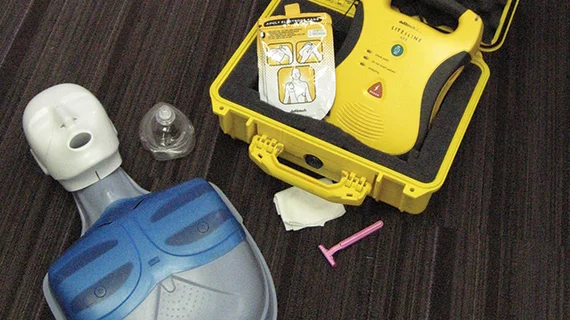Bystander CPR, defibrillation only helpful for finite period
Bystander intervention is crucial in saving the lives of individuals who suffer out-of-hospital cardiac arrest (OHCA), but patients are better off the sooner emergency medical services (EMS) personnel can take the reins. A new nationwide study from Japan highlighted the importance of timely ambulance arrival, showing that bystander defibrillation and cardiopulmonary resuscitation (CPR) are essentially worthless if EMS response times are slower than 13 minutes and 11 minutes, respectively.
“Beyond these time ranges, one‐month neurologically intact survival did not improve as a result of bystander intervention,” Yoshikazu Goto, MD, PhD, and colleagues wrote in the Journal of the American Heart Association. “Therefore, appropriate initiatives should be adopted to reduce EMS response time, and initiatives that aim to improve out‐of‐hospital cardiac arrest outcomes should also focus on factors besides EMS response time that may influence survival.”
Goto et al. analyzed records from 553,426 patients who experienced OHCA between 2010 and 2014. They studied the impacts of bystander intervention and EMS response times on neurologically intact survival, defined as a score of one or two on the five-part Cerebral Performance Category (CRC) scale.
Bystander defibrillation was found to increase the odds of neurologically intact survival by three-fold when response times were less than two minutes and five-fold when response times were 13 minutes. CPR more than doubled the odds off surviving with a CRC score of one to two when response times were within 11 minutes, with slightly less benefit seen for chest-compression-only CPR (1.92-fold better chances of neurologically intact survival).
However, the researchers noted these timeframes were the upper limits for which these actions were effective. After that, there was no significant increase in survival odds associated with bystander help.
They also pointed out the additional two minutes bought with defibrillation versus CPR “suggest that bystander defibrillation with bystander CPR may well be more effective than bystander CPR alone.”
“To increase the rates of bystander intervention before the arrival of EMS personnel, several strategies have been implemented in industrialized nations: traditional classroom training, dispatcher‐guided CPR, school‐based instruction, online education, and targeted neighborhood or individualized training,” Goto and coauthors wrote. “Despite these strategies and the increase in rates of bystander intervention, the rate of neurologically intact survival cannot improve if the EMS response time is too long.”
In this regard, the researchers reported 8 percent of patients who received layperson defibrillation and 12.5 percent of those who received any form of CPR had response times outside of those upper limits. Overall, each one-minute reduction in ambulance arrival was associated with 10 percent improved odds of one-month survival and 12 percent improved odds of neurologically intact survival.
Goto and colleagues acknowledged they lacked data on pre-existing comorbidities, the location of OHCA or the quality and timing of bystander intervention. Also, they said it may be difficult to extrapolate the results to other nations with different EMS systems and protocols.
Given that OHCA is possibly “the most time-sensitive and life-threatening medical condition,” two researchers proposed in an accompanying editorial to change the way response time is measured. The time from 9-1-1 call to ambulance arrival has several steps and as many opportunities for variability, they noted, whereas the time from 9-1-1 call to first bystander chest compression is much more direct and possibly more impactful to survival.
The telecommunication systems for this method are already in place and beginning to measure bystander response times would be significantly cheaper than reworking EMS systems, wrote Bentley J. Bobrow, MD, and Micah Panczyk, both with Arizona Emergency Medicine Research Center at the University of Arizona.
“We believe the time has come to emphasize a marker that measures proficiency earlier in the chain of survival and more closely addresses what matters most in the physiological aspects of cardiac arrest: the time from collapse to the initiation of CPR and defibrillation,” the editorialists wrote. “The interval from call receipt to first compression, if publicly reported, would no doubt increase the visibility and reinforce the life‐saving value and need for prearrival bystander action.”

